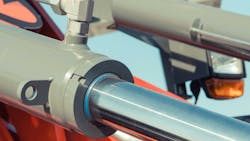Like any industry, the fluid power market ebbs and flows due to changes in economic conditions as well as technological advancements. On the technology side, it seems now more than ever that hydraulic and pneumatic systems are set to be displaced by electronic alternatives.
However, as the many interviews the Power & Motion team conducted over the last several weeks as part of our State of the Industry coverage — which offers a deeper look into technology and market trends impacting the fluid power and electronic motion control industry — indicated this is not the case.
There are applications in which electric actuators, for instance, are being utilized in place of hydraulic or pneumatic options. But there are also many applications in which fluid power solutions remain the best fit, at least with the technology that is available today.
One application Tom Diedrichs, Product Manager Actuators at Ewellix, noted in his interview with us that is currently difficult to apply electric actuators is excavators. The high shock loads which can occur when these machines are digging are challenging for current electric acuators to withstand. He said there are companies working to develop electric actuators which could at some point in the future be used in excavators. Watch our interview with Diedrichs below.
Opportunities Remain for Fluid Power Solutions
For now, excavators and many other heavy-duty mobile machines are among those applications in which hydraulics will likely continue to dominate. With that, there will be many opportunities for hydraulics manufacturers to bring new advancements to the industry. An area in which many are currently focusing is improving efficiency.
While powerful, hydraulics are also known to be efficient. Growing efforts to improve the efficiency of entire machines as part of sustainability initiatives are driving the need for more efficient hydraulics. This is an area in which representatives from Danfoss, HydraForce and others noted they are focusing development efforts.
Improved efficiency is also an area pointed to in the National Fluid Power Association's (NFPA) 2023 Technology Roadmap released earlier this year. A document which outlines target R&D areas for the fluid power industry, the roadmap offers insight into the many ways hydraulic and pneumatic systems can continue evolving to meet various customer requirements.
Greater incorporation of electronics, such as the integration of sensors, is an area bringing new capabilities to the market as well. Respondents from both the hydraulics and pneumatics side of the industry noted how incorporation of electronics is increasing and bringing several benefits, such as increased precision and the ability to gather performance data which can lead to improved maintenance by determining sooner if repairs or replacements are required.
The overall consensus from our State of the Industry interviews and research this year is there remains a bright future ahead for hydraulic and pneumatic systems. Electronics, either as a direct replacement or an accompaniment to fluid power solutions, are making inroads and may in some instances fully displace hydraulics and pneumatics.
But there are still many applications in which a fluid power-based motion control technologies are the better option. Given the many technological advancements taking place – and sentiments expressed by members of the industry – there remains a long life ahead for hydraulics and pneumatics.
We want to hear from you!
What new technologies or trends are you seeing in the fluid power market? How have you seen the implementation of electronic solutions evolve in recent years? What new opportunities do you see for hydraulics and pneumatics in the coming years?
Let us know! Email me at [email protected] or reach out to us on social media.
X (formerly Twitter): @TechnlgyEditor or @PowerMotionTech
LinkedIn: @PowerMotionTech
About the Author
Sara Jensen
Executive Editor, Power & Motion
Sara Jensen is executive editor of Power & Motion, directing expanded coverage into the modern fluid power space, as well as mechatronic and smart technologies. She has over 15 years of publishing experience. Prior to Power & Motion she spent 11 years with a trade publication for engineers of heavy-duty equipment, the last 3 of which were as the editor and brand lead. Over the course of her time in the B2B industry, Sara has gained an extensive knowledge of various heavy-duty equipment industries — including construction, agriculture, mining and on-road trucks —along with the systems and market trends which impact them such as fluid power and electronic motion control technologies.
You can follow Sara and Power & Motion via the following social media handles:
X (formerly Twitter): @TechnlgyEditor and @PowerMotionTech
LinkedIn: @SaraJensen and @Power&Motion
Facebook: @PowerMotionTech

Leaders relevant to this article:

